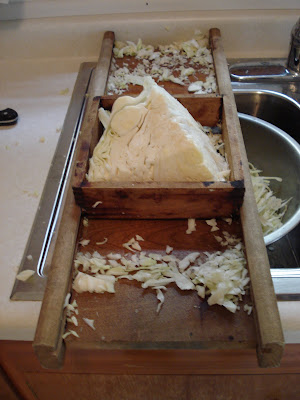
According to Mom, her nonna—my great-grandmother—spent hours and hours making ravioli for Christmas each year. They truly are a labor of love: between preparing the filling, making the pasta, rolling and assembling the ravioli, and making their sauce, it's like you've made the meal four or five times. When the food passes so many times through the hands of the cook, it cannot help but absorb what's in the heart of the cook.
And in my heart, there's joy to see the ravioli spring into the world out of nothing but flour, egg, pumpkin, and cheese. There's the warm companionship of cooking with my partner, Beth. There's a sense of connection with the women in my family, whose hands have also kneaded dough, rolled it thin, doled out filling, and set trim little pasta shapes on a floured towel to dry. And there's the anticipation of delight when, on Christmas Day, people we love will take pleasure and nourishment from the food we're making.
Ravioli di Zucca pa' Natale
That is to say, pumpkin ravioli for Christmas. This is my recipe, not Nonna's, but I hope she'd be proud. You can make the filling ahead of time and freeze it. You can also freeze the ravioli.
This recipe will make perhaps 80 or so ravioli. For a side dish, plan on 6 per person. For a main dish, plan on 9 to 12 per person.
The filling:
A pumpkin, 3-4 lb.
½ lb. grated Parmesan
Salt and black pepper to taste
The pasta:
5 c semolina flour (any other kind will work)
5 eggs
A tablespoon or two of olive oil
The sauce:
For every 6 ravioli you plan to serve,
1 T butter
2-3 sage leaves, fresh or dried
1-2 baby spinach leaves
1 T shaved Parmesan cheese
Ground black pepper
 Cut the top off the pumpkin. Hollow it out, then replace its lid. Place in a pan and bake at 375° for one to one and a half hours or until tender. Let cool.
Cut the top off the pumpkin. Hollow it out, then replace its lid. Place in a pan and bake at 375° for one to one and a half hours or until tender. Let cool.Peel the pumpkin, cut the flesh into small pieces, and mash it. Mix it with the Parmesan and seasonings to taste.

On a wooden cutting board or directly on your work surface, make a mountain of the flour. Make a volcano crater in it with your fist. Crack the eggs into the crater and add a splash of olive oil.
 Use a fork to whisk the eggs in the volcano crater. Whisk all around the edges of the crater. Flour from the volcano mountain is incorporated into the eggs as you go, and soon you are whisking a pale yellow batter. Go slowly so that the eggs whisk evenly and you avoid lumps.
Use a fork to whisk the eggs in the volcano crater. Whisk all around the edges of the crater. Flour from the volcano mountain is incorporated into the eggs as you go, and soon you are whisking a pale yellow batter. Go slowly so that the eggs whisk evenly and you avoid lumps.  Abandon the fork, toss a handful of flour on top of your dough, and start kneading in more flour. Gather, squeeze, and turn until the dough is like Play-Doh and does not feel tacky any more. There will still be flour left on your work surface; don't worry about that.
Abandon the fork, toss a handful of flour on top of your dough, and start kneading in more flour. Gather, squeeze, and turn until the dough is like Play-Doh and does not feel tacky any more. There will still be flour left on your work surface; don't worry about that. We rolled out to setting 6. We made rectangular sheets by cutting lengths, brushing the edges with water, and rolling the pieces together with the pin.
We rolled out to setting 6. We made rectangular sheets by cutting lengths, brushing the edges with water, and rolling the pieces together with the pin. While I was fussing with the pasta sheets, Beth made tidy little balls of filling. We placed them on a sheet several inches apart, keeping in mind that we would need a seam allowance between each dumpling.
While I was fussing with the pasta sheets, Beth made tidy little balls of filling. We placed them on a sheet several inches apart, keeping in mind that we would need a seam allowance between each dumpling. Cover with the other pasta sheet. Allow the pasta to drape over the filling. Seal the fillings in between the pasta sheets by pressing with your fingers. Avoid air pockets; you can get rid of trapped air by making a tiny slit with a paring knife, pressing out the air, then pressing the slit closed.
Cover with the other pasta sheet. Allow the pasta to drape over the filling. Seal the fillings in between the pasta sheets by pressing with your fingers. Avoid air pockets; you can get rid of trapped air by making a tiny slit with a paring knife, pressing out the air, then pressing the slit closed.Set a pot of salted water on the stove to boil. Heat the butter in a skillet or saucepan. Gently sauté the sage leaves until they are crispy; break them up in the butter a little. Sliver the spinach leaves.
Cook the ravioli. If they are fresh, this will take less than five minutes. If they are frozen, just drop them right in the boiling water without thawing.
Drain them well and arrange them on a plate. Drizzle them with the sage butter, sprinkle with shaved parmesan, and toss on a smattering of the spinach slivers. Finish with a grind or three of fresh black pepper.
Buon Natale, mios amicos.









































